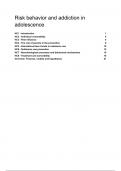College aantekeningen
All lectures 1-8 Risk behaviour and addiction in adolescence + Theories overview
This is a summary of all the lectures of Risk behavior and addiction in Adolescence. It contains a lot of information from the lectures in a short and clear way, without omitting usefull details. At the bottom of the document is a chart with the hypotheses, theories and models of the lecture and th...
[Meer zien]




